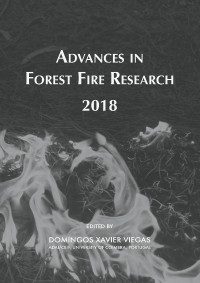Please use this identifier to cite or link to this item:
https://hdl.handle.net/10316.2/44548| DC Field | Value | Language |
|---|---|---|
| dc.contributor.author | Marcos, Elena | |
| dc.contributor.author | Fernández-García, Victor | |
| dc.contributor.author | Fernández-Guisuraga, José Manuel | |
| dc.contributor.author | Fernández-Manso, Alfonso | |
| dc.contributor.author | Quintano, Carmen | |
| dc.contributor.author | Calvo, Leonor | |
| dc.date.accessioned | 2018-11-09T12:21:58Z | |
| dc.date.accessioned | 2020-09-06T17:31:20Z | - |
| dc.date.available | 2018-11-09T12:21:58Z | |
| dc.date.available | 2020-09-06T17:31:20Z | - |
| dc.date.issued | 2018 | - |
| dc.identifier.isbn | 978-989-26-16-506 (PDF) | |
| dc.identifier.uri | https://hdl.handle.net/10316.2/44548 | - |
| dc.description.abstract | Fire is as a global phenomenon that represents one of the main disturbances in the Mediterranean Pinus forest ecosystem. It is also considered to be a soil forming factor and temporary modifier of soil properties. The degree of this impact depends on different factors such as pre-fire conditions, the type of soils affected, topographic and metereological characteristics and fire-regime attributes (e.g. fire size, recurrence, burn severity). In the last few decades, the fire regime is changing in some regions of the world including the Iberian Peninsula. This is the result of land abandonment, fire suppression policies and climate change. These factors generate a more favourable environment for the occurrence of large forest fires that may play a key role in affecting the natural rates and patterns of soils structure and functioning. As a consequence, both resiliency and sustainability of Mediterranean Pinus forest could be engaged. This survey is aimed at getting to know the effects of combined fire-regime attributes (recurrence and severity) on soil biochemical properties from a medium-term perspective (four years). The study was conducted in the Sierra del Teleno mountain range (León province; NW Iberian Peninsula). The climate is Mediterranean with 2-3 months’ dryness in summer. Soils are acidic (pH around 4.8) and mainly classified as Cambisol and Leptosol. A large wildfire occurred on August 19th 2012 affected an area of 119 km2 (103 km2 being occupied by Pinus pinaster Ait. forests). In this wildfire, a fire recurrence-severity map was elaborated by remote sensing methods, and validated using ground truth and with the information provided by the Regional Administration. We characterized fire recurrence throughout a 16-year period (1998-2014). Fire severity was measured by the dNBR (difference of the Normalized Burn Ratio) spectral index, and classified according to the ground reference values of the CBI (Composite Burn Index). We differentiated four scenarios of recurrence (low and high) and severity (low and high), and established a minimum of five 30m*30m field plots in each of the four recurrence-severity scenarios. In each field plot, we collected soil samples from a depth of 0-3 cm four years after the fire, and analysed the enzymatic activities β-glucosidase, urease, and acid-phosphatase and microbial biomass carbon. Four years after the fire, it can be observed that fire-regime attributes have a great influence on the resilience of soil properties. In the scenario of low recurrence-high severity, which means the highest intensity fire, decreased phosphatase and urease activities and soil microbial biomass carbon. This scenario showed a slight resilience to β-glucosidase activity but marked depletion in the other soil properties. High recurrence scenarios favour the recovery of soil biochemical and microbial properties. Soil enzymatic activities and microbial biomass could be a proxy to identify the general state of soil health after large fires. | eng |
| dc.language.iso | eng | - |
| dc.publisher | Imprensa da Universidade de Coimbra | por |
| dc.relation.ispartof | http://hdl.handle.net/10316.2/44517 | por |
| dc.rights | open access | - |
| dc.subject | enzymatic activities | eng |
| dc.subject | medium-term | eng |
| dc.subject | post-fire | eng |
| dc.subject | recovery | eng |
| dc.subject | soil microbial biomass | eng |
| dc.subject | wildfires | eng |
| dc.title | Soil resilience under different scenarios of fire recurrence and severity in Pinus forest ecosystems affected by large wildfires | por |
| dc.type | bookPart | por |
| uc.publication.firstPage | 288 | - |
| uc.publication.lastPage | 296 | - |
| uc.publication.location | Coimbra | por |
| dc.identifier.doi | 10.14195/978-989-26-16-506_31 | - |
| uc.publication.section | Chapter 2 - Fuel Management | por |
| uc.publication.digCollection | PB | por |
| uc.publication.orderno | 31 | - |
| uc.publication.area | Ciências da Engenharia e Tecnologias | por |
| uc.publication.bookTitle | Advances in forest fire research 2018 | - |
| uc.publication.manifest | https://dl.uc.pt/json/iiif/10316.2/44548/204063/manifest?manifest=/json/iiif/10316.2/44548/204063/manifest | - |
| uc.publication.thumbnail | https://dl.uc.pt/retrieve/11057462 | - |
| uc.publication.parentItemId | 55072 | - |
| uc.itemId | 68810 | - |
| item.grantfulltext | open | - |
| item.fulltext | With Fulltext | - |
| Appears in Collections: | Advances in forest fire research 2018 | |
Files in This Item:
| File | Description | Size | Format | |
|---|---|---|---|---|
| soil_resilience_under_different_scenarios.pdf | 880.93 kB | Adobe PDF |  |
Items in DSpace are protected by copyright, with all rights reserved, unless otherwise indicated.
